A calligraphy guide for beginners

Introduction
Calligraphy is an art that embodies cultural heritage, aesthetic principles, and the discipline of precise technique. We will embark on a journey to master the foundational strokes and principles of Chinese calligraphy, focusing on the character ‘永’ (yǒng). This character is ideal for beginners because it contains the eight essential strokes that form the foundation of countless other Chinese characters.
Learners will not only gain a practical understanding of how to execute these strokes but also appreciate the elegance and balance inherent in Chinese calligraphy. By mastering the character ‘永’ (yǒng), learners will develop the skills and confidence needed to explore more complex characters and compositions. Moreover, understanding the historical and artistic significance of calligraphy will provide a deeper connection to Chinese culture and traditions.
Step1: Prepare
Before we start, let’s get ready:
- materials:pencil, paper and I will provide an example word (need to print it off)
- posture:Sit upright with your feet flat on the floor. This helps you maintain control over your strokes.
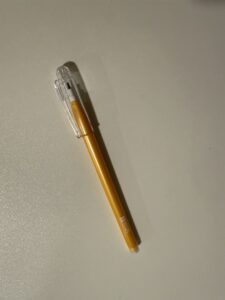
pencil
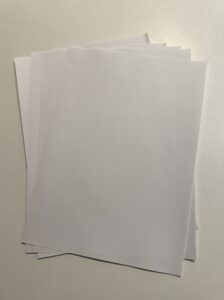
paper
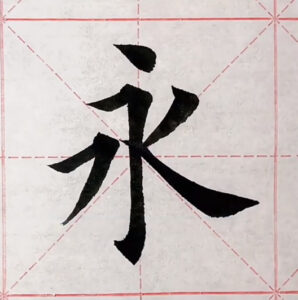
an example of the character ‘永‘(yong)
Step2: Watch a video
Feel the calligraphic strokes of the Yong character and understand the general stroke order and form.
Step3: Stroke analysis
Now, let’s learn the 7 fundamental strokes. Each stroke has its own character and flow, and together they form the complete the character ‘永’ (yǒng). I’ll guide you through each one, step by step.
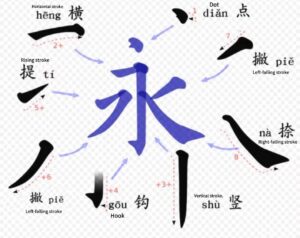
decomposition of strokes
Here’s the breakdown:
1、点 (diǎn) – Dot
- This small yet powerful stroke begins with a light touch, presses gently in the middle, and lifts off cleanly.
- Imagine a raindrop landing softly on the surface.
2、横 (héng) – Horizontal Stroke
- Start lightly, press down slightly as you move horizontally, and finish with a gentle lift.
- Focus on keeping the line even and steady.
3、竖 (shù) – Vertical Stroke
- This stroke is all about strength and stability. Start with a firm press and pull the brush straight down.
- A clean, vertical line conveys confidence.
4、撇 (piě) – Left-Falling Stroke
- Begin at the top and sweep diagonally to the bottom left.
- This stroke should flow naturally, like a tree branch bending in the wind.
5、捺 (nà) – Right-Falling Stroke
- Similar to 撇 but moves from the top left to the bottom right.
- Make this stroke deliberate and slightly longer to balance the character.
6、提 (tí) – Rising Stroke
- A quick, upward stroke that adds energy and lightness to the character.
- Think of it as lifting the brush off the paper gracefully.
7、钩 (gōu) – Hook
- Often attached to another stroke, the hook adds a sharp, dynamic twist.
- Focus on a smooth curve with a clean finish.
Step4: Getting into practice
Now that you’ve learned the individual strokes, it’s time to put them together.
Since not everyone has access to brushes and rice paper, we’ll use the double hook method to get a feel for the strokes and shapes of the character ‘永’ (yǒng), which only requires a pencil and white paper.
The Double Hook Technique is an essential tool for beginners. Using the simplest tools, it not only builds technical skills like precision and control but also fosters a deeper appreciation for the artistry and structure of Chinese calligraphy.
At the step I’ll provide a video of writing it.
Watch as I demonstrate the correct stroke order for the character ‘永’ (yong).
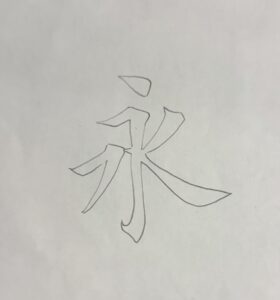
Here’s an example of the character ‘永’(Yong)I wrote
It’s practice time! Use the double hook technique to write the character ‘永’ (yǒng) multiple times, focusing on improving:
- Stroke consistency: Are your strokes uniform?
- Spacing and balance: Does each stroke have enough room?
- Overall structure: Does the character look cohesive?
Step5: Self-assessment
Now it’s time to evaluate your work! Comparing your strokes with a provided example is a great way to see how you’re progressing. Use the following checklist during your assessment:
- Stroke Accuracy: Are your strokes similar in shape, length, and thickness?
- Balance and Proportion: Does your character feel balanced, or do some strokes dominate?
- Flow and Consistency: Are the strokes connected smoothly?
These observations will guide you in refining your technique. Remember, the goal is improvement, not perfection!
Remember, calligraphy is a journey. The more you practice, the more you’ll enjoy its rhythm and beauty. Keep improving, one stroke at a time!
(The Classical Beauty of Calligraphy © 2024 by qianhan pan is licensed under CC BY-SA 4.0 )
(pencil © 2024 by qianhan pan is licensed under CC BY-SA 4.0 )
(paper © 2024 by qianhan pan is licensed under CC BY-SA 4.0 )
(an example of the character '永‘(yong) © 2024 by qianhan pan is licensed under CC BY-SA 4.0 )
(decomposition of strokes © 2024 by qianhan pan is licensed under CC BY-SA 4.0 )


